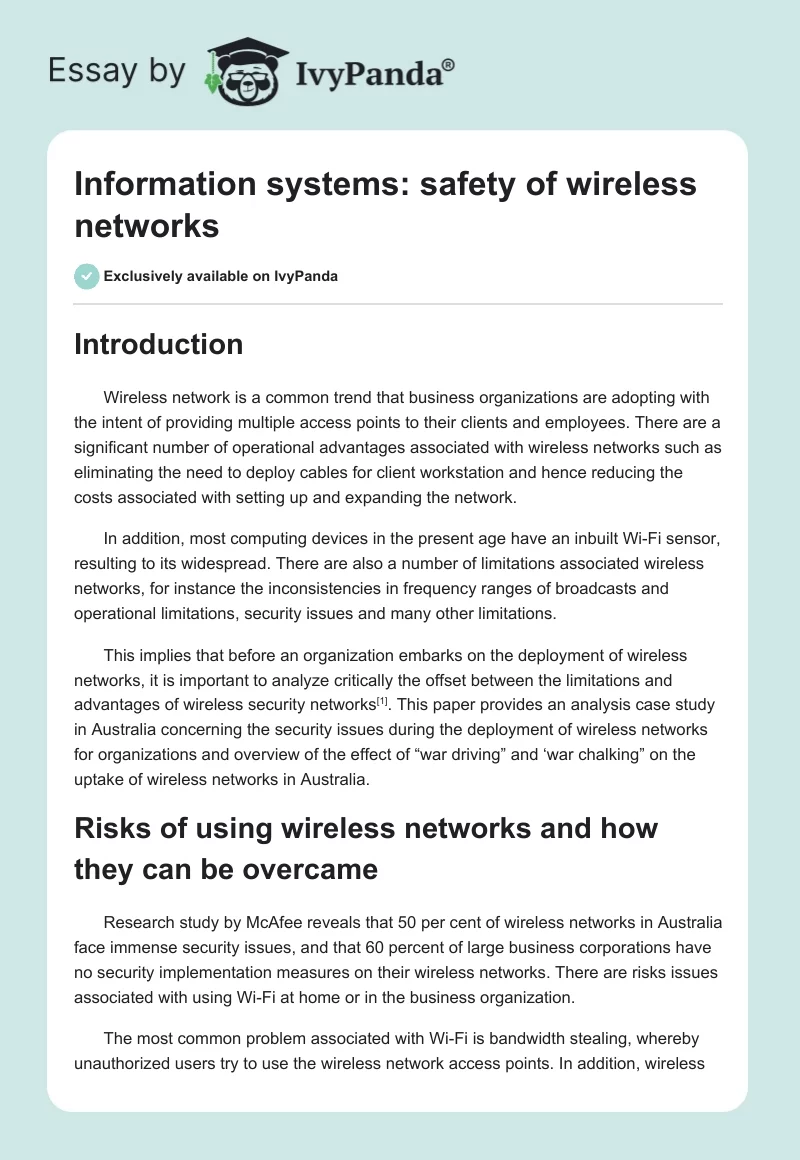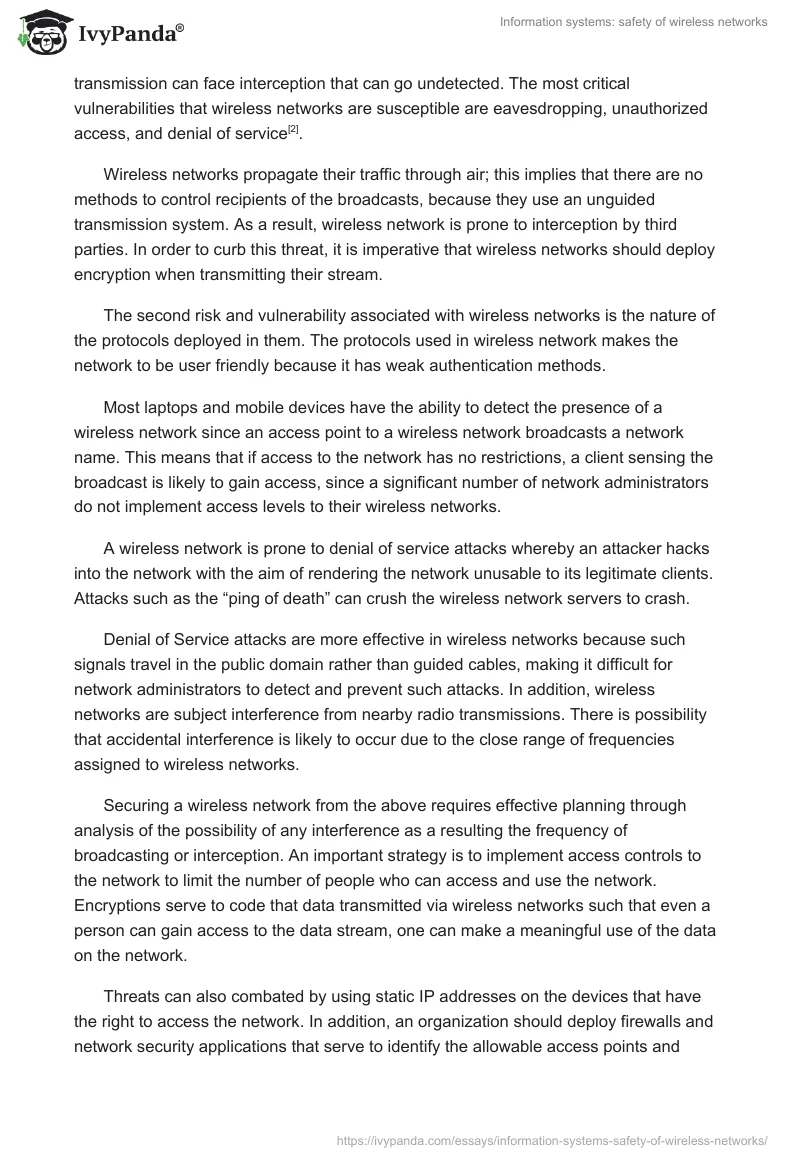Introduction
Wireless network is a common trend that business organizations are adopting with the intent of providing multiple access points to their clients and employees. There are a significant number of operational advantages associated with wireless networks such as eliminating the need to deploy cables for client workstation and hence reducing the costs associated with setting up and expanding the network.
In addition, most computing devices in the present age have an inbuilt Wi-Fi sensor, resulting to its widespread. There are also a number of limitations associated wireless networks, for instance the inconsistencies in frequency ranges of broadcasts and operational limitations, security issues and many other limitations.
This implies that before an organization embarks on the deployment of wireless networks, it is important to analyze critically the offset between the limitations and advantages of wireless security networks. This paper provides an analysis case study in Australia concerning the security issues during the deployment of wireless networks for organizations and overview of the effect of “war driving” and ‘war chalking” on the uptake of wireless networks in Australia.
Risks of using wireless networks and how they can be overcame
Research study by McAfee reveals that 50 per cent of wireless networks in Australia face immense security issues, and that 60 percent of large business corporations have no security implementation measures on their wireless networks. There are risks issues associated with using Wi-Fi at home or in the business organization.
The most common problem associated with Wi-Fi is bandwidth stealing, whereby unauthorized users try to use the wireless network access points. In addition, wireless transmission can face interception that can go undetected. The most critical vulnerabilities that wireless networks are susceptible are eavesdropping, unauthorized access, and denial of service.
Wireless networks propagate their traffic through air; this implies that there are no methods to control recipients of the broadcasts, because they use an unguided transmission system. As a result, wireless network is prone to interception by third parties. In order to curb this threat, it is imperative that wireless networks should deploy encryption when transmitting their stream.
The second risk and vulnerability associated with wireless networks is the nature of the protocols deployed in them. The protocols used in wireless network makes the network to be user friendly because it has weak authentication methods.
Most laptops and mobile devices have the ability to detect the presence of a wireless network since an access point to a wireless network broadcasts a network name. This means that if access to the network has no restrictions, a client sensing the broadcast is likely to gain access, since a significant number of network administrators do not implement access levels to their wireless networks.
A wireless network is prone to denial of service attacks whereby an attacker hacks into the network with the aim of rendering the network unusable to its legitimate clients. Attacks such as the “ping of death” can crush the wireless network servers to crash.
Denial of Service attacks are more effective in wireless networks because such signals travel in the public domain rather than guided cables, making it difficult for network administrators to detect and prevent such attacks. In addition, wireless networks are subject interference from nearby radio transmissions. There is possibility that accidental interference is likely to occur due to the close range of frequencies assigned to wireless networks.
Securing a wireless network from the above requires effective planning through analysis of the possibility of any interference as a resulting the frequency of broadcasting or interception. An important strategy is to implement access controls to the network to limit the number of people who can access and use the network. Encryptions serve to code that data transmitted via wireless networks such that even a person can gain access to the data stream, one can make a meaningful use of the data on the network.
Threats can also combated by using static IP addresses on the devices that have the right to access the network. In addition, an organization should deploy firewalls and network security applications that serve to identify the allowable access points and reports any additional access point that is not allowable on the list of static IP addresses assigned to MAC addresses of the hardware on the network.
Effect of “war driving” and “war chalking” on the uptake of wireless networks in Australia
War driving bases on the concept that it many operating systems such as windows makes it easy to detect wireless networks that are broadcasting in a given frequency range.
This means that roaming users can easily detect and access unsecure wireless networks. The relative ease by which users can detect wireless networks is what is called “war driving”. War driving has increased the people interest in driving around with the aim of locating and accessing wireless networks that require no authentication. In Australia, there are vast unsecured wireless networks, hence drawing user to map unsecure access points.
War driving is further enhanced by the fact that there are online utility software to aid in the detection of such wireless networks by laptops and mobile devices such as the PDA. In addition, the availability of many unsecured networks is one the most significant driving factors behind war driving. For instance, McAfee marketing directors reports that out of 622 networks found in Sydney’s North shore, 29 percent of these networks had no security implementation at all.
In residential areas such as the Neutral bay, he reports that 42 percent of the networks had no security measures, while those that attempted to implement security were using the older version of Wired Equivalent Privacy (WEP). This older version is prone to hacking, thereby facilitating unauthorized access by malicious users to the private and public wireless networks. This implies that war driving has had a significant effect on the security risks of wireless networks in Australia.
War chalking on the other hand refers to openly marking places that are access points to public wireless networks. War chalking is not common phenomenon in Australia because individuals who discover public access points are not willing to make it known that the area is an access point to a vulnerable wireless network.
Majority of individuals in Australia go out for war driving as a hobby, with the intent of collecting and pinpointing hotspots. The challenge to owners of vulnerable access points is that they cannot determine the attacker or the person who is responsible for jamming the network. In addition, network administrators have the challenge of determining whether a user is war driving for fun for the sake of a free connection or a attacker who aims at stealing information and rendering the network vulnerable.
This means that it makes it difficult to evaluate and implement security measures to such networks since most of them serve to attract clients to a business premise such as a hotel. However, the underlying requirement is that networks in Australia need to remain secure in order to avoid threats associated with war driving and war chalking.
Issues of security and privacy that organizations must consider when adopting a wireless network
Implementing a wireless network means that one is creating multiple access points to the network since there is no method for controlling the transmission of wireless networks. With regard to this, organizations have the need to implement the security and privacy policies regarding the ways in which the users can access the network. Implementing wireless security implies that the organization deploys various strategies aimed at limiting access to wireless networks.
Some of the security and privacy issues associated with unauthorized access that organizations must put into consideration include accidental association, malicious association, ad hoc networks, identity theft, and man-in-the middle attacks. In addition, there are security concerns regarding attacks such as Denial of Service attacks, network injection and Caffe Latte attack.
Accidental association is due the overlapping between wireless networks, making a user in such a hotspot a link between the two company networks. Malicious association on the other hand takes place when an attacker uses the network’s access points to impair the functionalities of the network and steal information.
Ad hoc networks are also a security concern in wireless networks because they tend to link two wireless networks in a peer-to-peer manner. Other attacks such as wireless network intrusion are a form of security threats that the organization must develop strategies to counter them.
Threats posed by war driving and war chalking to wireless networks
Despite the fact that most people on war driving and war chalking are undertaking it for the fun of enjoying a free wireless connection, some are some unscrupulous users who might this advantage to attack the network, as a resulting posing security threats to the network.
Depending on the knowledge of the user, one can pose a serious threat to the security of the network. There are diverse ways through which people on a war drive can use their knowledge to affect the security of a wireless network. For instance, a person can use his network security and cryptography skills to decrypt the contents of data stream in the network, thereby posing a threat of information theft to the organization.
People having a networking expertise can ping wireless network to obtain critical information concerning the configuration of the network, depending on their motives, they can initiate a denial of service attack or crush the whole network down by changing the configuration since most unsecure wireless networks have no access control strategies. There is also a possibility that people on war drive can bypass the firewall and access the organization’s critical information.
Issues to put into consideration when running free Wi-Fi services
Running free Wi-Fi services is a new trend that business enterprises are embarking on with the aim of attracting customers to their business premise. It is important for such businesses to put into consideration the security concerns associated with free Wi-Fi services, since it is difficult to ascertain the motive of the network user.
One strategy to ensure this is to facilitate the issuance of static IP addresses to users so that their activities on the network are traceable. Security applications such as proxy firewalls need to be implemented to the wireless network to enhance security.
Wireless network security application software
There are a number of applications used for tackling wireless network security issues. Some of them include Wi-Sentry version 4.2, Wi-Fi gear, and Wi-Fi Guardian. Wi-Sentry version 4.2 functions by performing a behavioral analysis and detection of devices that gain access to the wireless network. Therefore, Wi-Sentry ensures wireless network security through monitoring the access points in a network for rogue behaviors and ensuring that only authorized users get access to the network.
Wi-Fi guardian on the hand is utility software that aims at enhancing security to a wireless network. Some of the features of the software include high encryption, a client can surf safely in unsecured wireless networks, and a client in the wireless network is anonymous and not visible to other users in the network and an additional online server support with 100 percent availability. The software goes for $50 subscription annually.
The iOpus Private Internet Gateway is also wireless network security software (IPIG) that uses encryption to enhance security. The IPIG also fosters security through creation of a secure tunnel that aims at protecting a user’s communications bounds such as email and FTP in a wireless network. The IPIG is an open source application, meaning it is available free and its code can be modified.
Bibliography
Earle, A,. Wireless security handbook, Auerbach,New York, 2005.
Merritt, M., Wireless security, McGraw-Hill Professional,New York, 2005.
Randall, N., Wireless security: models, threats, and solutions, McGraw-Hill Professional, New York, 2002.


